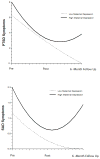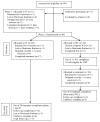Maternal depression and treatment gains following a cognitive behavioral intervention for posttraumatic stress in preschool children
- PMID: 23376601
- PMCID: PMC3578069
- DOI: 10.1016/j.janxdis.2012.11.003
Maternal depression and treatment gains following a cognitive behavioral intervention for posttraumatic stress in preschool children
Abstract
The evidence base for cognitive behavioral therapy (CBT) to treat child emotional and behavioral symptoms following exposure to trauma in youth is compelling, but relatively few studies are available on preschool children and on moderators of treatment outcomes. This paper examines maternal and child characteristics as moderators of posttraumatic stress (PTS) treatment outcomes in preschool children. Outcome data from a previously published randomized trial in three to six year old preschool children with diagnostic interview data from participating mothers were used. Hypotheses were tested via hierarchical linear modeling. Maternal depression was associated with higher initial child posttraumatic stress disorder (PTSD) symptoms, and was associated with increasing PTSD symptom trends at follow up suggesting potential child PTSD symptom relapse. Maternal PTSD symptoms similarly predicted differential child separation anxiety symptom change but not child PTSD symptom change. Targeting dyads with child PTSD symptoms and maternal depression or PTSD symptoms with enhanced interventions may be a useful strategy to improve treatment maintenance.
Copyright © 2012 Elsevier Ltd. All rights reserved.
Figures



References
-
- Allen A, Saltzman WR, Brymer MJ, Oshri A, Silverman WK. An empirically informed intervention for children following exposure to severe hurricanes. The Behavior Therapist. 2006;29:118–124.
-
- Altman DG, Schulz KF, Moher D, Egger M, Davidoff F, Elbourne D, et al. The revised CONSORT statement for reporting randomized trials: Explanation and elaboration. Annals of Internal Medicine. 2001;134:663–694. - PubMed
-
- American Psychiatric Association. Diagnostic and statistical manual of mental disorders. 4. Washington, DC: Author; 1994.
-
- Berman SL, Weems CF, Silverman WK, Kurtines WK. Predictors of outcome in exposure-based cognitive and behavioral treatments for phobic and anxiety disorders in children. Behavior Therapy. 2000;31:713–731.
-
- Bryk AS, Raudenbush SW. Application of hierarchical linear models to assessing change. Psychological Bulletin. 1987;101:147–158.
Publication types
MeSH terms
Grants and funding
LinkOut - more resources
Full Text Sources
Other Literature Sources
Medical

